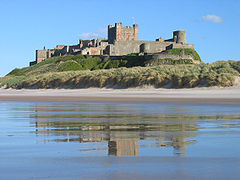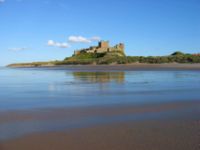- Bamburgh Castle
-
Coordinates: 55°36′29″N 1°42′32″W / 55.608°N 1.709°W
Bamburgh Castle 
Bamburgh Castle from the beach
 Bamburgh Castle shown within Northumberland
Bamburgh Castle shown within NorthumberlandOS grid reference NU184350 List of places: UK • England • Northumberland Bamburgh Castle is an imposing castle located on the coast at Bamburgh in Northumberland, England. It is a Grade I listed building.[1]
Contents
History
Built on a basalt outcrop, the location was previously home to a fort of the native Britons known as Din Guarie and may have been the capital of the British kingdom of the region (see Gododdin, Bryneich and Hen Ogledd)[2] from the realm's foundation in c.420 until 547, the year of the first written reference to the castle. In that year the citadel was captured by the Anglo-Saxon ruler Ida of Bernicia (Beornice) and became Ida's seat. It was briefly retaken by the Britons from his son Hussa during the war of 590 before being relieved later the same year.
His grandson Æðelfriþ passed it on to his wife Bebba, from whom the early name Bebbanburgh was derived. The Vikings destroyed the original fortification in 993.
The Normans built a new castle on the site, which forms the core of the present one. William II unsuccessfully besieged it in 1095 during a revolt supported by its owner, Robert de Mowbray, Earl of Northumbria. After Robert was captured, his wife continued the defence until coerced to surrender by the king's threat to blind her husband.
Bamburgh then became the property of the reigning English monarch. Henry II probably built the keep. As an important English outpost, the castle was the target of occasional raids from Scotland. In 1464 during the Wars of the Roses, it became the first castle in England to be defeated by artillery, at the end of a nine-month siege by Richard Neville, 16th Earl of Warwick.
The Forster family of Northumberland[3] provided the Crown with twelve successive governors of the castle for some 400 years until the Crown granted ownership to Sir John Forster. The family retained ownership until Sir William Forster (d. 1700) was posthumously declared bankrupt, and his estates, including the castle, were sold to Lord Crew, Bishop of Durham (husband of his sister Dorothy) under an Act of Parliament to settle the debts.
The castle deteriorated but was restored by various owners during the 18th and 19th centuries. It was finally bought by the Victorian industrialist William Armstrong, who completed the restoration.
During the Second World War, the Royal Navy corvette HMS Bamborough Castle was named after it.
The castle still belongs to the Armstrong family, and is opened to the public. It also hosts weddings and corporate events. It has been used as a film location since the 1920s, featuring in films such as Ivanhoe (1952), El Cid (1961), Mary, Queen of Scots (1972), and Elizabeth (1998).
Vicinity features
About 6 miles (10 km) to the south on a point of coastal land is the ancient fortress of Dunstanburgh Castle and about 10 miles (16 km) to the north is Lindisfarne Castle on Holy Island.
Environmental factors
Air quality levels at Bamburgh Castle are excellent due to the absence of industrial sources in the region. Sound levels near the north-south road passing by Bamburgh Castle are in the range of 59 to 63 dBA in the daytime (Northumberland Sound Mapping Study, Northumberland, England, June, 2003). Nearby are breeding colonies of Arctic and common terns on the inner Farne Islands, and of Atlantic puffin, shag and razorbill on Staple Island.
Archaeology at Bamburgh
Since 1996, the Bamburgh Research Project has been investigating the archaeology and history of the Castle and Bamburgh area. The project has concentrated on the fortress site and the early medieval burial ground at the Bowl Hole, to the south of the castle.
Archaeological excavations were started in the 1960s by Dr Hope-Taylor, who discovered the gold plaque known as the Bamburgh Beast as well as the Bamburgh Sword.
The project runs a training dig for 10 weeks every summer for students to learn more about archaeological techniques and to further research into the Castle.
Armstrong and Aviation Artefacts Museum
The castle's laundry rooms feature the Armstrong and Aviation Artefacts Museum, with exhibits about Victorian industrialist William Armstrong and Armstrong Whitworth, the manufacturing company he founded. Displays include engines, artillery and weaponry, and aviation artefacts from two world wars.
Bamburgh Castle in film and television
- 1927: Huntingtower
- 1984–86 Robin of Sherwood
- 2001: Revelation
- 2010: Robin Hood (2010 film)
- 2011: Channel 4's Time Team dug at Bamburgh Castle
See also
Notes
- ^ "Images of England: Bamburgh Castle". English Heritage. http://www.imagesofengland.org.uk/details/default.aspx?pid=1&id=237848. Retrieved 2007-12-05.
- ^ 'An English empire: Bede and the early Anglo-Saxon kings' by N. J. Higham, Manchester University Press ND, 1995, ISBN 0719044235, 9780719044236
- ^ The History and Antiquities of North Durham Rev James Raine MA (1840) pp306-10 History and pedigree of Forster family
External links
References
- Bamburgh Castle
- Bamburgh Research Project
- Images of Bamburgh castle
- Glen Lyndon Dodds, (Albion Press, 2002), Historic Sites of Northumberland & Newcastle upon Tyne, pp 33–39
- David Ford Nash, "Early British Kingdoms".
- Fry, Plantagenet Somerset (1980). The David & Charles Book of Castles. Newton Abbot: David & Charles. pp. 182–183. ISBN 0-7153-7976-3.
County Durham Northumberland Alnwick · Aydon · Bamburgh · Belford · Bellingham · Bellister · Belsay · Berwick · Blenkinsop · Bothal · Bywell · Callaly · Cartington · Chillingham · Chipchase · Cotherstone · Coupland · Creswell · Dally · Dilston · Dunstanburgh · Elsdon · Etal · Featherstone · Ford · Haggerston · Halton · Haltwhistle · Harbottle · Haughton · Langley · Lindisfarne · Mitford · Morpeth · Norham · Ponteland · Prudhoe · Rothley · Tarset · Thirlwall · Twizell · Wark (on Tweed) · Wark (on Tyne) · Warkworth · WiddringtonTyne and Wear Categories:- Castles in Northumberland
- Country houses in Northumberland
- History of Northumberland
- Grade I listed buildings in Northumberland
- Visitor attractions in Northumberland
- Historic house museums in Northumberland
- Archaeological sites in Northumberland
- Technology museums in the United Kingdom
- Reportedly haunted locations in England
Wikimedia Foundation. 2010.






